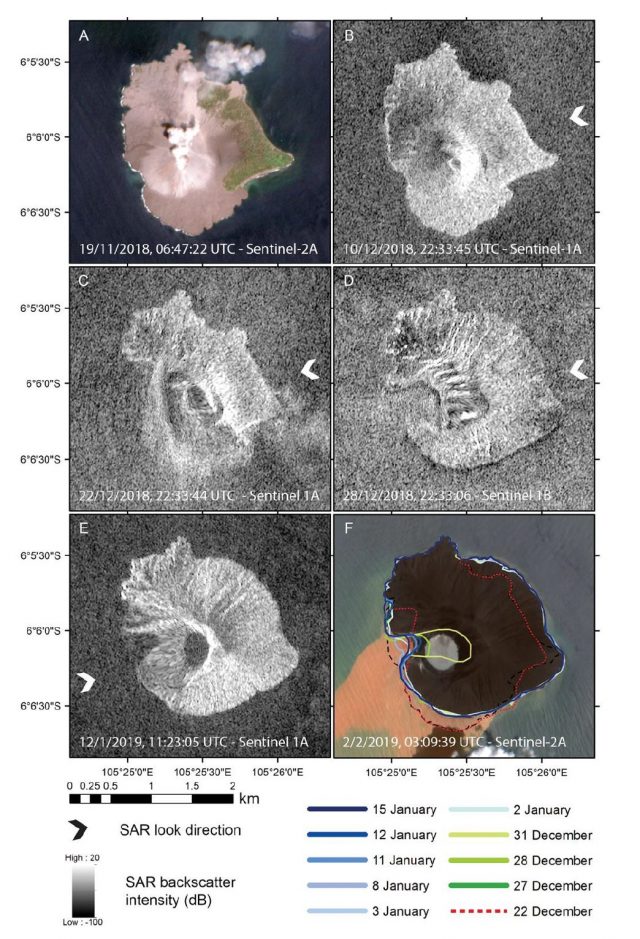19 February 2019
New on EarthArXiv: a first analysis of the flank failure of the Anak Krakatau volcano
Posted by Dave Petley
New on EarthArXiv: a first analysis of the flank failure of the Anak Krakatau volcano
A paper has recently been posted to the open source repository EarthArXiv that provides a first analysis of the flank failure of Anak Krakatau volcano on 22 December 2018, which generated a tsunami that killed 431 people. The paper, Williams et al. (2019), uses a combination of remote sensing and eyewitness accounts to examine the sequence of events that generated the tsunami. Regular readers of the blog will remember that at the time it was quite difficult to untangle the sequence as volcanic eruptions before and after the collapse changed the topography quickly.
Williams et al. (2019) provide a particularly interesting perspective on the radar imagery collected over that period. Interestingly there is an animation of the radar sequence on Youtube, which also includes some initial interferometric analysis by reader funkenbeachin. InSAR is very difficult in a massif that has undergone so much change, but the radar sequence is very revealing:-
.
Williams et al. (2019) note that Sentinel-1A captured an image about 8 hours after the initial collapse event. This is shown in Panel C in the image from the paper below:-

Satellite imagery of the series of events before and after the flank collapse at Anak Krakatau on 22 December 2018. Imagery from Sentinel-1A and Sentinel-2A
.
Williams et al. (2019) propose that the initial failure event consisted of an approximately 100 million cubic metre submarine failure, with a comparatively small (4 million cubic metre) terrestrial component. They suggest that the main part of the flank collapsed completely to generate the tsunami, with a smaller block, higher on the island, partially failing in a rotational manner to generate the approximately north-south orientated plane visible in the imagery. The failure decompressed the plumbing of the volcano to allow a new magma pathway to open, allowing the subsequent eruptive activity.
I am intrigued by the fate of this smaller partially failed block – if I was a referee I would want this to be considered more directly. This block does not appear in image D above, suggesting that it has failed in a second event. Did this occur in one movement or was it eroded away during the subsequent eruptive activity? The question of sequencing of flank failures is really important to understand likely tsunami generation, so this feels like a key issue.
Perhaps the most important part of this paper is this section:-
“We show that the flank failure was unexceptional, meaning that an extraordinary event was not required to trigger the tsunami, yet it had catastrophic consequences…The volume of the flank failure was small, compared to predicted collapse volumes and flank collapses at 25 other volcanoes, yet it generated a tsunami as large as and faster than modelled with a significantly larger collapse…this study also highlights that existing hazard assessments at volcanic islands are very likely underestimating the risks from volcanogenic tsunamis due to small (<0.25 km³) failures.”
That feels to me to be a very important set of conclusions from a very interesting and useful initial analysis.
Reference
Williams, R., Rowley, P., & Garthwaite, M. C. 2019. Reconstructing the Anak Krakatau flank collapse that caused the December 2018 Indonesian tsunami. EarthArXiv. https://doi.org/10.31223/osf.io/u965c


 Dave Petley is the Vice-Chancellor of the University of Hull in the United Kingdom. His blog provides commentary and analysis of landslide events occurring worldwide, including the landslides themselves, latest research, and conferences and meetings.
Dave Petley is the Vice-Chancellor of the University of Hull in the United Kingdom. His blog provides commentary and analysis of landslide events occurring worldwide, including the landslides themselves, latest research, and conferences and meetings.